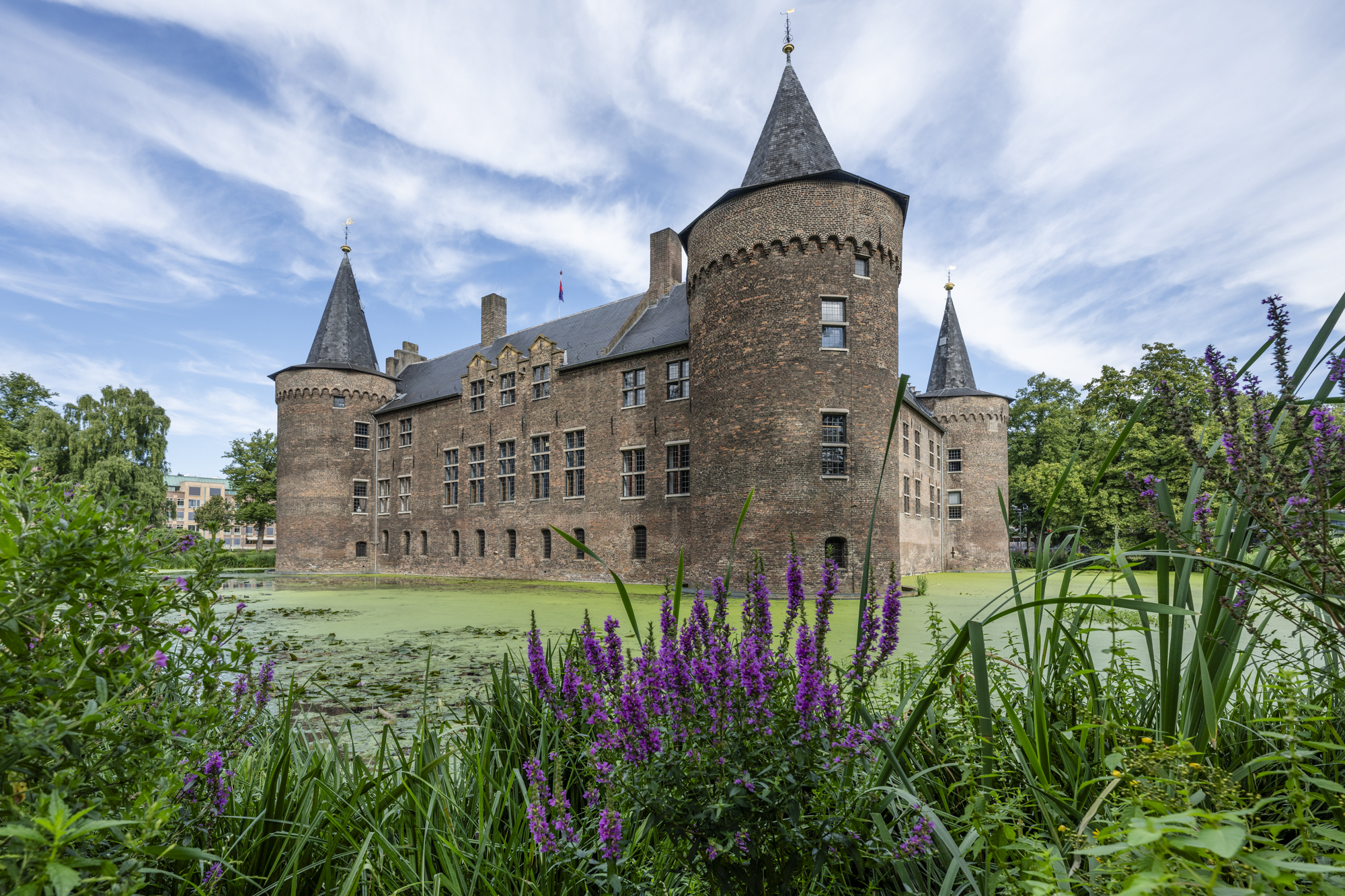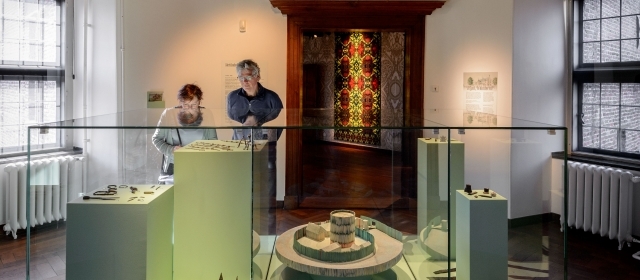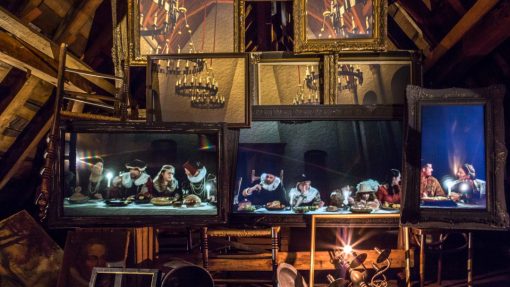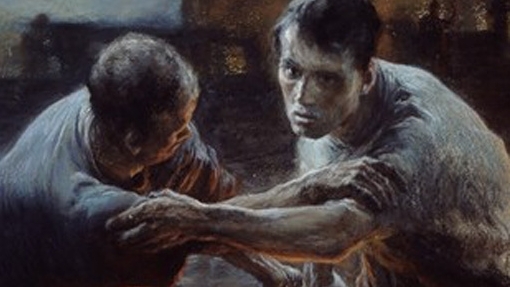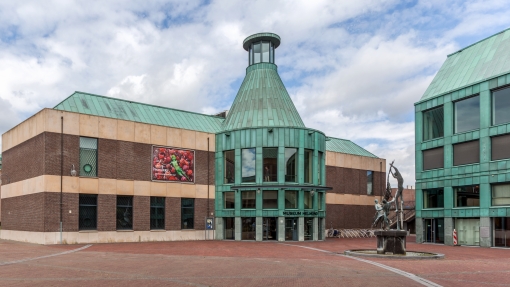
- 1 January 2016
- 1 January 2040
- Kasteel Helmond
The castle story
Centuries of history
‘On the south side of this town there is a castle, which in past times served to defend and protect it; it is a strong, old and beautiful building, which has remained undamaged in the numerous Wars between the Dukes of Gelder and Brabant.’ This is how Reverend Stephanus Hanewinckel describes the Helmond castle in 1800. Helmond Castle is actually the ideal castle, the noble house of our dreams: heavy walls, towers, spiers and steep roofs, reflected in the moat. The only thing we miss are the battlements, but on closer inspection even those in the wallwork are still present. Despite all the changes, such as the construction of the massive Vlisco factory halls in the castle garden and the construction of the elevated Kasteel-Traverse right in front of the castle, the building is still a dominant presence in the cityscape. Besides being the archetype of the medieval castle, it is also the only example of a square castle in North Brabant. A much older castle, the ‘Oude Huys’ a little further southeast, preceded it.

View of Helmond before 1800. In the late eighteenth century, the towers of the castle and church dominate the city. The four towers of the castle are clearly visible. Anonymous, 1775–1799, Helmond Museum collection.
The largest square moated castle
Helmond Castle has existed for almost 700 years. It is the largest existing square moated castle in the Netherlands. Through a combination of findings from building history research – which led to a date in the second quarter of the fourteenth century – and the loan that Lodewijk Berthout van Berlaer took out in 1331 with Helmond Castle as collateral, we can set the foundation date as ca. 1331. Get to know the families that have lived in Helmond Castle over the centuries.
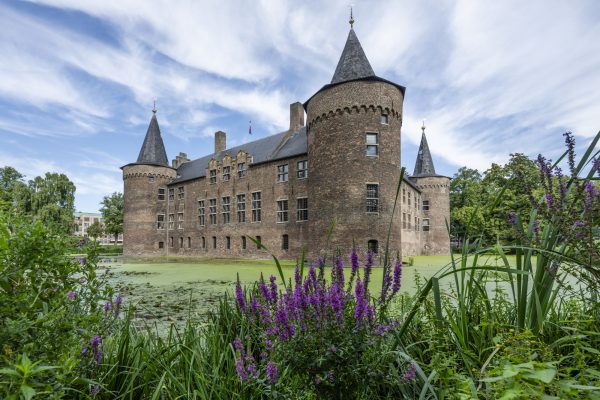
Helmond Castle, Dave van Hout
The Van Berlaers
When Duke John II of Brabant died in 1312, his twelve-year-old son John III was not yet fit to rule. Floris Berthout is then an important man at court; one of the two regents who govern the duchy on behalf of the young duke. Floris comes from a family that was first mentioned around 1200 and originated from Berlaer near the city of Lier. He sees an opportunity to strengthen his position of power by transferring Helmond to his distant and now very impoverished relative Jan I Berthout van Berlaer. As a manor with growth opportunities, Helmond is worth much more than the assets at Lier. There incomes are low and also heavily taxed.
It seems like an uneven transfer. On July 5, 1314, the young duke Jan III attached his seal to a deed in which he exchanged the manor and several other valuable objects for the possessions of Jan I Berthout in Lier and the surrounding area. Jan then receives ‘the village, the house, the perck, (…) the mill and the lant van Helmondt’ as fief. Den perck is the hunting area of the duke, which also includes the Warande forest. In this way, Floris strengthens his position at court.
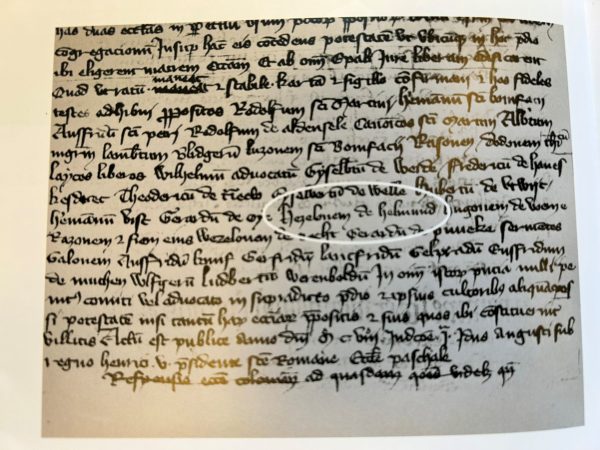
‘Hezelonem de Helmond’ is the oldest mention of the name Helmond. In a deed from 1108, a Hezelo van Helmond is mentioned as a witness (The Utrecht Archives).
A new castle
Jan I van Berlaer wins a manor with sufficient income and possibilities. And the duke strengthens his ties with the loyal Van Berlaer family. Jan I Berthout van Berlaer probably visited Helmond occasionally and stayed in the ‘Oude Huys’. But the castle is somewhat dated. It is located low in a swampy environment, which changes in character due to desiccation. It is probably his son Lodewijk van Berlaer who opted for a new castle. The new castle, Helmond Castle, is being built near the city founded by the duke almost a century earlier.
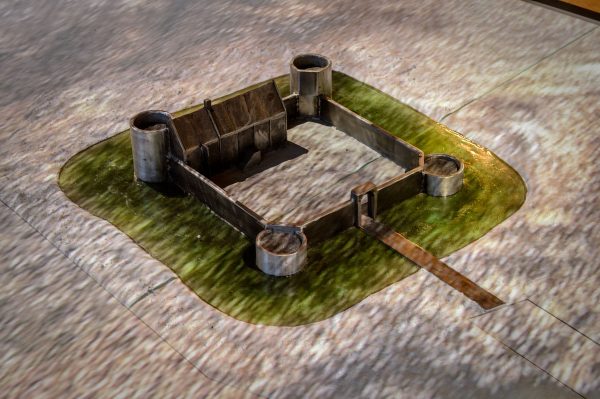
The castle in one of its earliest phases. The floor plan of the square moated castle was already present in the years after 1331. This lead scale model is part of the projection in the Van Berlaer Hall.
Cortenbach’s family
The young Catharina van Berlaer inherited the rights to the manor of Helmond in 1474, she is the daughter of Jan III van Berlaer (died in 1425) and Margriet van Lyshout. Catharina married Jan I of Cortenbach in 1433. It was a marriage for political and strategic reasons, as was the case at the time. Catharina faced a challenge: her father had saddled her with many debts. The expansion of the castle and the legacies for the many illegitimate children of John III had cost a lot of money. She died in 1447. Nearly a century later, Joost van Cortenbach, leader of the armies of Emperor Maximilian I, Philip the Fair and Charles V, fought against the Gelderland Duke Charles and his army captain Maarten van Rossem. He regularly fortifies and defends the city and castle.
The castle fire
It was not a nice or quiet time for the residents of Helmond, the population was heated by the wars in Brabant. To make matters worse, flames burst out of the castle on the night of February 10 to 11, 1549 at 2 a.m. The wooden roof structures and wooden floors are severely damaged. But Joost van Cortenbach does not leave it at that and tackles the rebuilding energetically. He also wants the excess of opulence and wealth that he saw as a young squire at the impressive court of Charles V in Brussels in Helmond. After the fire, the sturdy, defensible castle with its robust halls and rooms becomes a luxurious residential home.
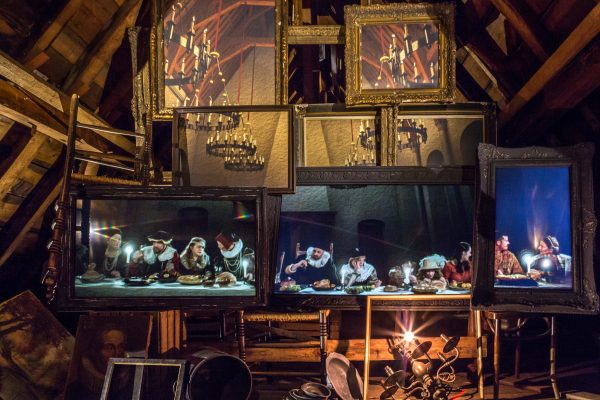
Visit the authentic castle attic and discover the story behind the castle fire in 1549.
Eighty Years’ War
We jump back in time, it is 1578, the Eighty Years’ War is in full swing. Adolf van Cortenbach is the lord of the castle in Helmond. With his wife Philippine van Ruyschenberg they have seven children. Adolf died in 1594, after which Philippine took over the government. It is a turbulent time, with sieges and plundering. Ultimately, she succeeds in getting Stadtholder Maurits to declare the castle neutral territory. In 1609, the city welcomed Alexander, Philippine’s second son, as lord of Helmond with three pots of wine, a sum of money of approximately 285 guilders and a ‘honorable meal’ with friends.
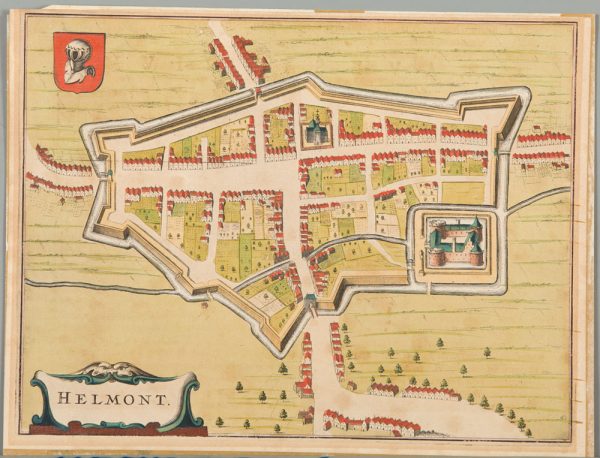
Map of Helmond within the ramparts. Right below the castle. There are also buildings on the four thoroughfares outside the fortress. The Helmond coat of arms is depicted at the bottom left of the cartouche “Helmont”, at the top left. Joan Blaeu (1596-1673), dated 1649, Helmond in 1602.
The lord stands his ground during his reign, he wants more influence and starts building a gate on the north side of the castle, as accommodation for the city council. That will cost him dearly to the people of Helmond, they dump their ash heaps in front of the gate. A lawsuit follows in 1631 and ultimately a compromise: no more ash heaps if the lord acknowledges that the land belongs to the city. And so there are more disputes between the lord and the Helmonders. The city is struggling and poor, it is 1648 and most of the weavers have already left for Haarlem.
The last nobility: the Van Arbergs
The disaster year 1672 also left its mark in Helmond, tenants and tenants were bankrupt. Brabant is a battleground for the attacks on the Republic. The destruction is so great that Emond van Cortenbach (son of Alexander), married to Cecile Isabella Gonzaga (daughter of the Duke of Mantua, Italy) has seen his wealth evaporate. Perhaps after his death she married Antoine Udalrique van Arberg for that reason in 1683. The new lord of Helmond, who acts on behalf of his stepdaughter Isabelle Felicite. The marriage did not last long, Cecile Isabella died in 1688. Before her death, she granted her 9-year-old daughter permission to marry Antoine Udalrique’s 32-year-old brother, Albert Joseph van Arberg. Short-tempered by nature, Albert has already committed a manslaughter in Liège, and conducts numerous trials in Helmond to defend his rights and interests. At the beginning of their marriage, the couple lived mainly in the south, after which they lived for more than 10 years in Helmond, where they formed a French-speaking enclave.
Albert Joseph modernizes the castle. In 1688, for example, the south wing received a Baroque facade with two corner buildings and stairwells. Everything is also changing inside. The couple is renovating, among other things, the knight’s hall, known as ‘the zaele’, ‘le grand salon’ or ‘the blue hall’. In the adjacent room there is a large iron steam bath dating from 1781 that probably dates from the time of Antoine and Isabelle. There are also eight paintings hanging, the bather can look at them nicely. The couple is also concerned with the garden, which is becoming elegant and a pleasant place to stay and stroll. There will be ponds and avenues, and the couple will also create forelands so that you can walk along the castle walls.
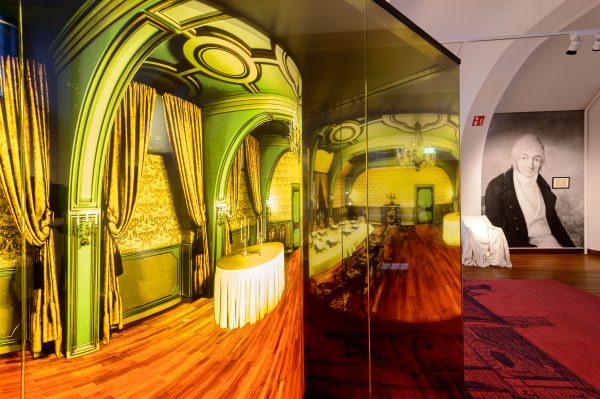
The light showcase symbolizes the luxurious home in the Van Arberg period. In the background the portrait of the last lord of the castle from this family, Nicolas Antoine van Arberg (1736-1813).
In the eighteenth century the time of glorious habitation is over, the castle is still inhabited by about ten residents, including Goort the teulknecht, Josijn de Vrouw, Frans the porter and Mr Intendant Van den Berghe. Albert Joseph still occasionally stayed in Helmond and donated the manor to Maximilian van Arberg in 1720, who in turn gave it to his son Nicolas Antoine in 1767. But the castle was now heavily mortgaged and he wanted to get rid of it.
A citizen as a gentleman: the Wesselmen
Carel Frederik I Wesselman buys the manor of Helmond on October 19, 1781, which almost certainly saves the castle. He paid 155,000 guilders for it, one of the highest amounts for a manor from that period in North Brabant. The manor of Helmond is the largest and richest in the province after that of Tilburg. The gentleman is no longer a noble, but comes from the upper middle class. Wesselman is also a Protestant who moves to the castle and gets involved in the well-being of the city. Carel Frederik comes from a German family of traders and large landowners, with properties in Gelre. Their wealth mainly comes from inheritances and shares in the Dutch East India Company. Carel Frederik buys the manor of Helmond because of the rights and the income, a real castle with proud towers and centuries of history increases its status.
Shares in ships & plantations
The new lord spends a lot of money on repairing and beautifying the castle. A watercolor probably made by Mattheus Derk Knip from 1806 shows how decorative whitework around the roof cornices of the towers and around the gate arch makes the dark brick more lively. Carel Frederik has shares in ships and plantations that transport goods such as elephant teeth, gold and enslaved people from the west coast of Africa. The weather vane in the shape of a ship on the northwestern castle tower is a reminder of his trading activities in Africa and Asia.
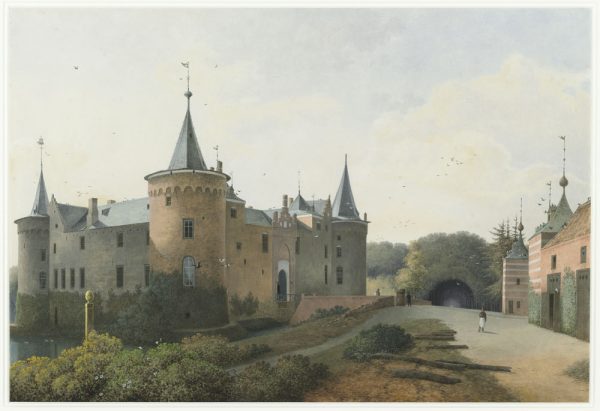
Mattheus Derk Knip, the castle around 1800, 1806-1845.
The ideals of the French Revolution
He tackles those who are behind in paying taxes and rents, and he also spends a lot of money on improving his lands, meadows and meadows. That fits with his interest in trade and agriculture. Carel Frederik is also active in securities trading and founded the bleaching, weaving and damask weaving mills Wesselman, Bogaers and Sanders. But the lord’s rights had their day in 1789. The ideals of the French Revolution also penetrated the Netherlands and Helmond. On April 23, 1795, the people of Helmond elected a new and Catholic city council for the first time, and a few years later Carel Frederik lost his rights as lord of Helmond.
Nobility at the castle again
In 1810, his son Carel Frederik II became mayor of Helmond, and like his father he showed an interest in land reclamation and agriculture. The construction of the Zuid-Willemsvaart in the Aa river basin took place between 1823 and 1826 using the outer canals of the castle, it is the most important achievement of Carel Frederik II. In this way the city gains a favorable position in trade and transport. In gratitude for his services, Carel Frederik II was elevated to the nobility, from 1881 the family was called Wesselman van Helmond.
In 1895, Carel Frederik IV Wesselman inherited the castle, where he lived with his wife Marie de Jonge van Zwijnsbergen and their children. However, the castle became an increasingly heavy burden for the couple and in 1910 part of the southern garden was sold to Vlisco, the textile factory founded in 1846 by P. Fentener van Vlissingen and Co. On March 1, 1921, the municipal council received the keys to the castle, ending private residence.
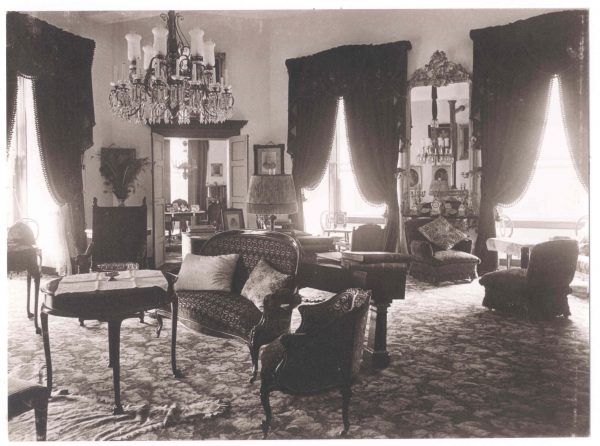
This is what the living room looked like in the time of the last lord of the castle, Wesselman van Helmond.
The castle as the heart of the city
The heart of the city, that is the castle in the eyes of mayor Marinus van Hout (1870-1942). He finds support from the government and the province for the restoration of the now dilapidated castle. Architect J.W. Hanrath (1867-1932) drew up the building plan, based on the most ideal condition, its ‘original architectural beauty’. For Helmond, this means going back to the late Middle Ages by removing later additions, also seen as mutilations. L.A. Springer (1855-1940) designed the garden.
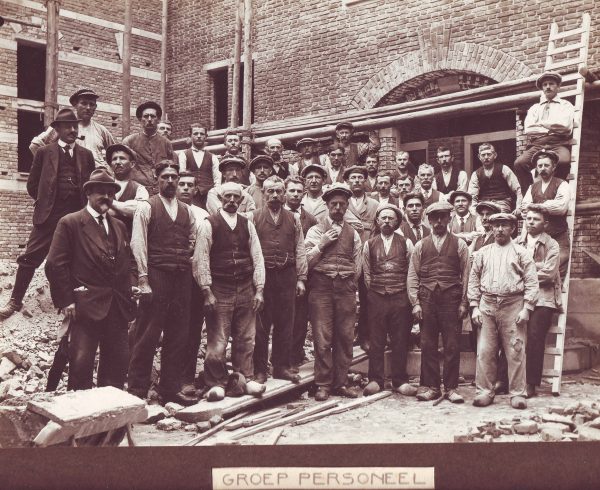
The workmen are almost finished in 1923 and pose in front of the new entrance. On the left in the first row is Hanrath with hat and pipe.
The internal restoration and renovation is even more comprehensive. For example, built-in corridors and rooms are disappearing, and pipes are being laid for central heating, electricity and water. New floors will be installed on the first floor and dividing doors will disappear. Fortunately, much has been preserved, such as the oldest work of art in the castle, the painted panel with the weapons and quarters of the Cortenbach and Arberg families. The late Gothic ceilings with their carved key pieces can also still be seen.
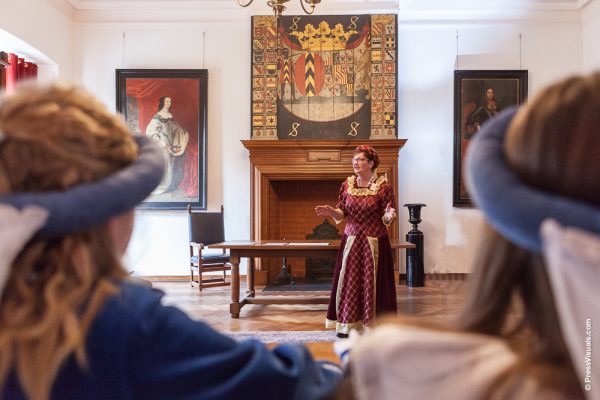
The painted panel with the weapons and quarters of the Cortenbach and Arberg families in the Jan van Berlaerhall.
On a beautiful spring day in 1923 (Thursday, April 5), the ceremonial opening of the new town hall took place. For the first time in its existence, the castle is a public building and the time when, in the words of mayor Marinus van Hout: “a small monarch made the laws for his subordinates, and which – through the Duke of Brabant – comes to an end forever endowed with the low, middle and high jurisdiction – could dispose of the life and death of his residents.”
From castle to museum
Archivist Jac. Heeren is the first curator of the museum, which officially opened on October 17, 1929. The museum consists of a few rooms in the town hall, and is much more of an antiquities room with a collection about Helmond’s past, with objects such as an old loom, shearing window and a traveling carriage. In 1980 there are new developments, the civil servants leave for the new town hall and the Queen’s Commissioner opens the newly furnished museum in 1982. Art historian Jan van Laarhoven and also museum director has ambitious plans: within five years the museum must grow into a medium-sized museum with its own face. A collection of contemporary art followed in 1985, which from 2001 can be seen in temporary exhibitions in Kunsthal Helmond in the then brand new Boscotondo complex, a few minutes’ walk from the castle. And so today Museum Helmond exists with two locations: Helmond Castle and Kunsthal Helmond.
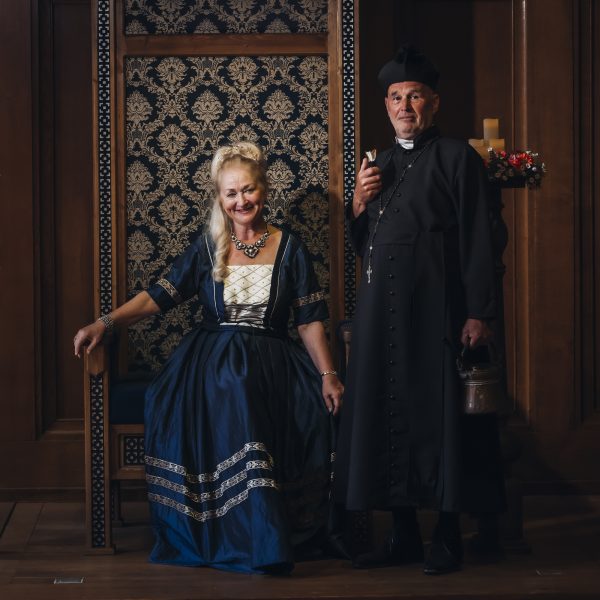
Meet the castle residents during the holiday periods! Photo: Dave van Hout.
The text above is composed of information from the book ‘Helmond Castle, biography of a moated castle’ (only available in Dutch). Do you want to know everything that is known about our castle? Visit the castle for the Castle Story, the permanent exhibition. The castle story was made possible by VSB Fonds, Mondriaan Fund, Rabobank Coöperatiefonds, Bouwfonds Cultuurfonds, Prins Bernhard Cultuurfonds, J.A. Raymakers & Co BV, SteunWelzijnszorg Helmond, Vereniging van Vrienden, and others.


